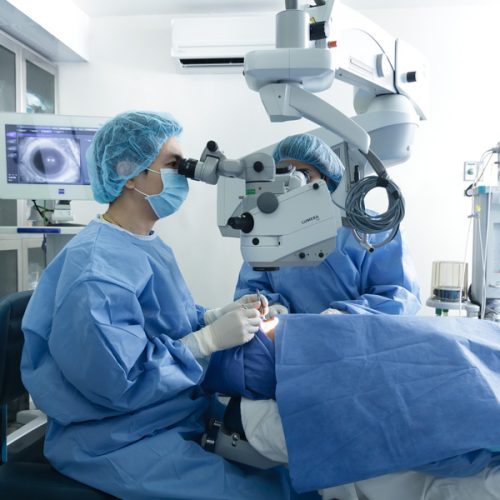Cataract is the leading cause of treatable blindness. It can be cured with today’s technology and advances in medicines.
A Cataract is a yellow discoloration or a cloudy opacity of the natural lens inside the eye. It is usually due to aging. Uncontrolled diabetes and eye injury may hasten Cataract development leading to a Cataract operation.
We offer efficient and careful Cataract screening services to help you choose your intraocular lens, coupled with cataract surgery by internationally-trained doctors that use some of the most advanced tools and equipment in the world. Rest assured that pain level is tolerable and not as painful as you might think.

Addressing Common Cataract Questions
Cataract is yellow discoloration of the natural lens inside the eye. Other types of Cataract may cause opacities in the natural lens.
Cataract development is part of the aging process. As we age, there are also changes in the natural lens of the eye.
Cataract in its early stage may not cause any visual symptoms. As the cataract matures, it can cause blurring of vision often described as cloudy vision. Cataracts may also cause glare and night vision problems. Several people with cataracts have difficulty driving at night because of glare from headlights of oncoming cars. Cataracts may also cause errors of refraction. Individuals with cataract may become near-sighted or far-sighted. They may also develop astigmatism. As the cataract worsens, their near-sightedness, far-sightedness or astigmatism increase. They may need to change their glasses very often. Cataracts can also cause loss in contrast sensitivity and double or triple vision.
Cataract is detected through an eye examination by an ophthalmologist. Medical history is taken first to detect any medical conditions, such as diabetes, chronic steroid use and previous ocular trauma, that may have contributed to cataract formation. The medical history also helps to determine if the patient is a good surgical candidate for cataract surgery. After that, a thorough eye examination is performed. This starts with determining the visual acuity or level of vision in each eye. Refraction is performed to measure the error of refraction, or the amount of near-sightedness, far-sightedness or astigmatism. Cataracts are best seen by slit-lamp examination. A slit-lamp is a low-power microscope combined with a high intensity light source that can focus a thin beam of light inside the eye. To make sure one gets excellent results after a cataract surgery, an ophthalmologist will also check your eye pressure, your retina, macula and optic nerve. This is to ascertain that you do not have any eye problems other than the cataract. During the examination, you may receive one or several drops to your eyes to numb your eyes (for the eye pressure test) and dilate your eyes (in order to check the retina, macula and optic nerve).
Presently, there are no eye drops or medicines to treat a cataract. The only way to treat cataracts is by removal through cataract surgery.
There are 2 ways in which the cataract can be removed. The first option is by creating a C-shape incision on the eye. The cataract is taken out as a whole through this incision. Several sutures are required to close the incision. The second option is called phacoemulsification. This technique uses ultrasound delivered by a pen-like instrument or a probe. Only two small incisions are required for phacoemulsification. The probe is inserted through the incision and dissolves the cataract. At the same time, the probe also sucks the dissolved cataract out of the eye. In order for the eye to see clearly again, an artificial lens or an intraocular lens (IOL) is inserted inside the eye to replace the cataractous natural lens during cataract surgery. This IOL is implanted to the bag that once held or supported the natural lens. All cataract surgeries are now done with insertion of an IOL.
The risks of cataract surgery include infection, corneal edema, macular edema, rupture of the posterior capsule, vitreous loss, inability to implant an intraocular lens during the surgery and retinal detachment. Fortunately with today’s modern technology, the chances for developing these risks are small.